MHK Suzanne Bryan interviewed me a month after I received my MHK certification. I hope it can help or inspire others in the program:
https://youtu.be/Ce9y_SMfiGs
Summary of previous Levels 1&2
Sep 2, 2020: Ordered Level 1
Sep 23, 2020: Submitted L1
Nov 9, 2020: Received feedback
Resubmit for Level 1
Sw 7 enlarged st in ssk
Sw16 add row to balance cable vertically
Q 4, 8, 11
Nov 23, 2020: Passed MHK L1
L1 140/759/264
§§§§§§§§§§§§§§§§§§§§§§§§§§§§§§§§§§§§§§§§§§§§§§§
Took a month off before ordering Level 2.
Dec 31, 2020: Ordered MHK Level 2
March 5, 2021: Submitted Level 2
May 8, 2021: Received feedback
Resubmit for Level 2:
Swatch: one buttonhole
Project: wristlet needs better contrast of one color.
Clarify a book as a design book
Add a phrase to instruction sections
Waiting for a skein of Finullgarn to arrive in the new color to show better contrast between 2 of the colors in the wristlet.
May 18, 2021: Resubmissions sent
May 28: Notified that the Resubmits maybe lost in the mail. My local post office claims that packages passing through the Pennsylvania Office are often lost and it is known to be “The Black Hole”. Reassembled the requested items again for review.
June 5, 2021: Passed MHK L2
This time ordered the next level the same day of passing the previous level. Projects, swatches, and papers are getting more interesting!
L2: 75/272; 175/273
120/158
§§§§§§§§§§§§§§§§§§§§§§§§§§§§§§§§§§§§§§§§§§§§
June 5, 2021: Ordered Level 3 159/121
Sep 20, 2021: Submitted MHK L3 binder and projects
Resubmit
Different CO and BO pairing
Redo corner on one BO
Use a lighter color on a swatch
Be less concise
December 24, 2021. Co-chair congratulated me on becoming a Master Knitter.
§§§§§§§§§§§§§§§§§§§§§§§§§§§§§§§§§§§
Master Knitting Fun Facts from group discussion:
#MK 255 in U.S. + 33 in 9 other countries
#MK in US Regions:
West: 58
Midwest: 69
Southwest: 15
Southeast: 46
Northeast: 64
The 3-Levels Master Knitting is designed to take 4.5 years to complete but you can ask for an extension.
Completing in 3 yrs is considered very fast.
Some people mentioned taking 7y, 14y and 11y.
The fastest through the program:
CathyCrafter (NY) 18 mos; Feb10-Aug11
Peggy SpinWyn (CA) 18 mos Jan08-Jul09
heyKerrieAnn (NC) 14.5 mos Sep20-Dec21
qAthena (PA) 19.5 mos Mar21-Oct22
MK that had no resubmits on one of the levels: Abigail
Youngest Master Knitter is a teenager
MK use both English and Continental styles
No tally on RH v LH.
§§§§§§§§§§§§§§§§§§§§§§§§§§§§§§§§§§§
I thoroughly enjoyed this program. I applied a strategy I learned in business classes: I compartmentalized and focused on one item at a time as listed in the Instructions. For each swatch even the basic ones:
-
I read through the instructions for each swatch and the related items in the Question section to gain an idea of what the review committee felt was important.
-
I researched, tried out various techniques from CastOn articles or books from the library.
-
I noted my preferred methods along with top references on techniques and the research and noted my experiences in a composition book.
-
I sometimes read articles and history behind the techniques on a swatch. This renewed my enthusiasm toward every swatch and my momentum seemed high as I knew I’d learn something new or have a new perspective even on familiar techniques.
-
It is helpful to do the written work first; I usually wrote up the book and magazine reviews before the longer reports.
-
I would set up my new binder and, on the computer, I’d set up and name all the doc and files I would need so I could add notes and links as I went.
-
Then I’d copy the heading template on all the SIS pages and copy entries from the previous level’s biography to the new master bibliography so it is ready to adjust or add to.
-
Before knitting each swatch, I’d read the instructions and related questions. Then I’d read all related CastOn articles and the reference books making notes in a separate composition book as I went along. I wrote out tentative instructions on techniques and rough drafts of the swatch pattern. My composition book had graph pages so I could chart out swatch designs or sections of the project. All the above was done in the car while I was away from the house 9-11 hours each day with the boys sports and practices.
-
I saved the swatch knitting for the few hours mid morning when I had the best natural light and could focus on the knitting in quiet and no distraction. I found that my knitting had remarkable tension by being able to mindfully focus on it and I had a critical eye and could catch any area I wanted to redo before I got too far with the swatch. I’d review the swatches later after a break and only felt the need to reknit a couple of them before submitting my binder for review. This simple mindfulness saved me a lot of time.
-
Review all instructions and compare to written and knitted work before submitting the binder.
Knitting and written work for the MHK Program:
Level 1
Blocking report
20 Swatches if including preliminary swatch
44 Question total when including parts of questions and short essay answers
1 Written pattern
5 Worksheet charts
1 Project: mitten w Estonian lace cuff, jogless stripe
Level 2
History Report
4 Book reviews
21 Swatches total if including swatch 13a,b,&c
33 Questions including parts of questions
4 Charted designs
8 Written patterns
3 Projects: FairIsle Wristlet, Argyle sock w intarsia, vest with seamed sides and pickup neck and arm opening sts for ribbing. Used own design in rib/cable.
Level 3
Fiber Report of animal, plant, and synthetic fibers
Ethnic Knitting Report
2 Book reviews
2 Magazine reviews
19 Swatches
30 Questions including parts of questions and short essay answers
3 Written patterns using written row by row instructions
5 Written patterns using charted designs
2 Projects: Aran Sweater & FairIsle Hat
1 FairIsle Hat Pattern
1 Aran Sweater Pattern
The sweater and hat have their own project pages:
https://www.ravelry.com/projects/heyKerrianne/aran-sweate...
https://www.ravelry.com/projects/heyKerrianne/fair-isle-c...
Beginning MHK Level 3
June 5: Printed out and read the General Info and Instructions
Chose two books for review.
Library has Ann Budd’s Handy Book of Patterns
I ordered Janet Szabo’s Aran Sweater Design
I ordered an issue of Piecework magazine and considering the online Knitty magazine for my second magazine review.
This weekend will read history and traditional patterns of Fair Isle in Alice Starmore’s and Ann Feitelson’s books on Fair Isle and re-read chapter eight in Richard Rutt’s History of Hand Knitting.
Later will read Gladys Thompson’s book on Guernseys, Jerseys, and Arans, Starmore’s book on Aran Knitting, and Harmony Guide to Aran and Fair Isle.
Favorite resources for the previous Levels 1 & 2 were
Hiatt’s Principles of Knitting (older edition)
Vogue Knitting (older edition)
Stanley’s Reader’s Digest Handbook of Knitting
Bliss’s The Knitter’s Book of Knowledge
Radcliffe’s The Knowledgeable Knitter
Radcliffe’s Book of Answers
Bajus’s The Joy of Color
Heard Buss’s Big Book of Knitting is useful in Level 3.
Considering a Cast On and Bind Off book, Mucklestone’s Fair Isle Motif book,
and Park’s Book of Yarn.
June 6-12th
Worked swatches 1-10
Sw1 Tubular CastOn w JBMC and work 2 full rounds and Tubular Bindoff w Kitcher St and working 4 row set up for two rows of tubular st.
Sw2 Twisted Blended Decreases from knit side
Chinese Waitress CO and BO
Sw3 Twisted Full Fashion Decreases from purl side
Cable CO and BO
Sw4 CDD (s kw, K2tog, p) w Picot CO and BO
Sw5 Mitered Double Decrease (s2 tog kw, K1, P)
German Twisted CO and Icelandic BO
Sw6 CDI Channel Island CO and Russian BO
Sw7 Harringbone St; Cable CO and BO
Sw8 Honeycomb Brioche
Sw9 Double Knit Invisible ItalianCO and Kitchener BO
Sw10 Entrlac PurlOn CO and
Sw11 DoubleRib Smocking St LTCO w 1 selvedge st.
June 13-19
Sw12 Elongated St (Seafoam Pattern) used German Twisted and Icelandic BO
Sw13 Slip Stitch (Garter Brick Pattern) using German Twisted CO and Russian Decrease BO
Sw15 Mosaic using German Twisted CO and Russian Decrease BO
Also this week I packed up our family for two month trip to Midwest and prepared our OuterBanks home for summer guests.
June 20- 27
Sw14 Bavarian using LTCO and Std BO
Sw16 Charted Symbols- used both lace and cable symbols. LTCO and Std BO.
Sw18 Duplicate Stitch after reading articles recommending single st lines for duplicate st, I decided not to do my initial chart I designed because the letter was formed by lines two sts wide. I used Stitch Fiddle app to draw a simple heart that satisfies the requirement of incorporating vertices, horizontal, and diagonal lines.
Typed up templates for the SIS.
Worked on pattern writing on the swatches.
Drew up chart ideas for the intarsia swatch
Ordered yarn for the intarsia swatch #17.
Had a cookout with extended family and grilled bratwurst and sausages from a German deli.
June 28-July 3
Sw17 Did a Robin Redbreast for the intarsia design and embroidered the eyes, legs, and a couple of snowflakes.
Drew up different crown design for the hat.
Started knitting the brim using the LTCO in purl and purl first row to produce a small rolled edge similar to a thin ICord that I learned from a sock KAL w Suzanne Bryan.
Re knit the whole brim using German Twisted CastOn because I felt the corrugated Ribbing needed a cleaner, straight cast on edge than the LTCO in purl provided.
Meg Swansen recommends German Twisted CO to keep corrugated ribbing from flipping: http://fairisleknitting.blogspot.com/p/tips-and-tricks.html
Charted out hat body and crown on carting software.
Finished editing charts for swatches.
Wave cable w bobble:
https://www.bromefields.com/day-9-wavy-bobble-cable-knit-...
July 5 Finished Fair Isle hat
July 5-8 Swatched several cable designs
Drawing ways to coordinate cable panels and figure out the set up Row and increases after rib and before the cable charts. Figuring out number of repeats and shaping for shoulder and neck. The designing Aran sweater book by MHK Janet Szabo has excellent info for different sleeve options but she did not go into detail for the bottom up Aran raglan knit flat—just saying it is trickier and has more math than knitting it top-down, in-the-Round. I special order the book hoping she’d shed some insight into the seamed Aran raglan. I’ve done lots more research. It does require more math but it’s math we’ve been doing and this is an example when Row gauge comes into play. You’ll want to know out how wide you want the neck and sleeve tops. Calculate the number of rows you need for the raglan shaping by taking your desired raglan depth and row gauge. Then figure out how many sts need to be decreased over that number of rows and make sure the row count is the same on either side of the raglan seam between the sleeve and body. Some designs have a shorter raglan seam on the front compared to the back, so adjust the sleeve raglan shaping to match.
I usually work the sleeves first as a gauge swatch, but I will work the sweater back first to set the guide for raglan shaping and determine and see how the neck depth and shaping will look with the cable panels vertical balance with placement of neck front.
For the Sleeves, I’ll determine how wide I want the top of the sleeves and their effect on the neck opening. The determine how many sts to decrease over the number of rows I calculated earlier to match up with the body.
July 11: Typed up pattern for Fair Isle Cap
Inserted all charts into SIS and Question/Answer folders.
Started the ribbing for Aran Sweater.
July 16: Grafted yet more charts for the Aran sweater.
Swatched the cables going into the ribbing. Tried double ribbing and twisted single rib.
July 15 Finished the ethnic knitting report.
Answered charted symbols and knitted-on lace edging questions.
July 22-25 Took a family trip to Mackinac Island.
Oldest son played the piano in the Geranium Room of the Grand Hotel.
He is wearing the vest I made for Level 2.
The Aran Sweater project was carried in the backpack and brought with me everywhere on the island.
August 10: Finished the sweater back and started on the sweater front.
Picked up the color print outs for the intarsia swatch and the Fair Isle pattern charts that used color.
Finished documenting different symbols used in charting and finished the rest of the question section. Returned the tall stack of reference books to the library before we head back to NC this week. Our library in the OuterBanks is rather limited on knitting references—I’ve enjoyed having such a good library here in the Midwest during this summer.
Aug 27: Finished the front panel
Aug 28: Swatched for 48-st Cuff and 52-st; decided to go with 52-st Cuff.
Sep 2, 2021: Started second sleeve
Sep 9: Seamed sweater from base of arms to neck to pick up stitches for neck band. Folded neck and stitched to the inside resulting in appearance of double row of crochet stitches on the inside.
Sep 12 blocked Fair Isle hat over a new sauce pot wrapped in Saran Wrap.
Sep 16&17: Seamed sleeves and sides of body in Irish Moss section. Sweater is done (8 weeks and 1 day)
Sep 17: Swatch 19. Tried different pinhole cast on techniques (Suzanne Bryan demonstrating Emily Ocher approach, Roxanne Richardson, using Provisional CastOn w crochet hook so that initial loops are stable; CastOn Mag, Jen Ardel, who draws up two loops and passes one loop over second to add one stitch at a time which also keeps loops even and stable). Prefer Emily Ocher like Suzanne Bryan but using DPNs instead of two cable needles. Double wrap circle over couple fingers and pinch crossing strands together with LH. Hold working needle in RH and add sts w yo, and drawing a loop through the yarn ring.
Sep 18: wove yarn tails in and blocked nine swatches at same time the sweater is blocking.
Sep 20: Wrote pattern for Aran Sweater and drew up the schematic. It is ready to send.
Nov 19, 2021: My Co-chair gave me the heads up that my binder was finished being critiqued by the guild members and was safely with her but it would be a couple weeks into December before she could review it.
December 6: Binder arrived. Sweater, hat and reports passed and they said overall knitting and pattern writing was very good. I need to re-finish the corners on one of the bind offs, choose a different CO/BO for one of the swatches, re-knit a swatch because the navy was too dark to evaluate the stitches, I was too concise in some areas of my writing on some answers and pattern instructions. I need to darken the grid lines on my charts.
December 12: Finished the knitting and written work. I had looked at several chart making apps and really liked how Stitch Fiddle is organized. I can customize the stitch and row gauge on the charts, and liked the selection of cable and lace symbols. But…… the grid lines were too light requiring me to resubmit all the charts. Adjusting the darkness of the grid lines is available on their upgrade version but I was using the Basic version. I had to open up the app and draw over all the grid lines you hand!
Everything is complete. I just need to pick up the charts that were printed in color at the office store when I drive into Nags Head tomorrow.
December 14: I dropped the resubmissions at the post office this morning.
Christmas Eve Day morning: My husband made some boiled custard eggnog for the first time as a treat—I couldn’t believe the light, delicate texture and flavor of the homemade eggnog. With all the teenage boys at home, I had conducted an eggnog taste test of several different brands of eggnog earlier in the week. We definitely plan to add making this recipe to our traditions!
I checked my email as I was watching a Christmas movie with my family. My co-chair, Joyce Jones, had sent me some feedback on my submission last night and mentioned she would be on the road all weekend. I quickly answered a couple of issues she wanted clarified and she responded back at noon while on the road and congratulated me on becoming a Master Knitter! It was even more special to receive the news while my oldest son was still home on Christmas break to share in the celebration!
Additional Photos
Submitted photos of my favorite knitting spot (Our natural light filled family room and my favorite knitting organizer for The Knitting Guild newsletter:
My tool clutch:
- Extra cables to hold stitches,
- Bulb-shape stitch markers: a. Can work as Row Counters—I do some kind of sequence of ROYGBIV and use Red to indicate Row 1. I can alternate them with the unpainted silver markers if I have a design for every other row. b. Can be used as end stoppers on the cable ends so stitches don’t slide off— the unpainted ones even fit through the smaller holes of the Mini Cables.
- Small crochet hooks for Provisional CastOns and a rosewood one that is perfect for crochet edgings in fingering weight.
- Not pictured is #3 crochet thread which is good for Provisional CastOn and is smooth and slippery for holding stitches.
- KnitPicker/mini latch hook to help create loops on zipper tape when installing zippers.
- Good quality mini scissors.
- #18 tapestry needles
- Metal rulers
- Thick sticky rubber band to tighten Interchangeable needle tips.
- Nail file and nice hand cream.
- Nostepinne to create or neaten up the balls of yarn. My college-age son made these handy size nostepinnes in different exotic woods and uses the same 18-step finishing process he uses for his hand- lathe pens. He was taught by a Master Wood Turner, who then sponsored him in the International Wood Turning Guild. This son has been very supportive of my own journey in the Master Hand Knitting. The nostepinne even held the 365y of Aran weight wool for the L3 Aran sweater!
Favorite knitting nook in our family room with plenty of natural light from the large angled windows. Knitting references are in the cabinets of the TV credenza.
Summer 2021, as I started Level 3, my two older boys lifeguarding at a 50 meter pool. Scot had lifeguards for four years and this was Jack’s first year as lifeguard.
Photos from our family summer trip to Mackinac Island.
Scot surf fishing on our beach while visiting during his fall break. I was able to check the Aran sweater sleeve lengths. When Scot had last seen his future sweater, I had only done a couple of cable repeats on the sweater back and it was just a short rectangle band to hold up and show.
Lots of swatching accomplished while waiting on my middle son during morning and afternoon swim practices as he is on both his high school team and US Swim Teams.
Learned I passed and became a Master Knitter on Christmas Eve day. Went to waterfront Christmas Eve services—Scot is wearing his new sweater.
Boys hold up their favorite gifts
Youngest: Short trench jacket and bird feeder.
Middle: German Merkur safety razor and shaving soap.
Oldest: Vince Guaraldi LP and a puzzle of Anne Hathaway’s Cottage near Stratford-upon-Avon—a nod to a favorite trip to England.
 HeyKerrieAnn >
HeyKerrieAnn >  notebook > projects > MHK L3 + Link to Interview
notebook > projects > MHK L3 + Link to Interview 










































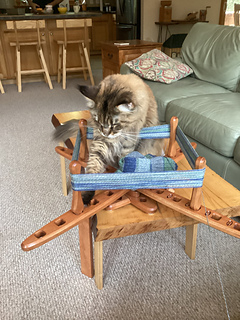


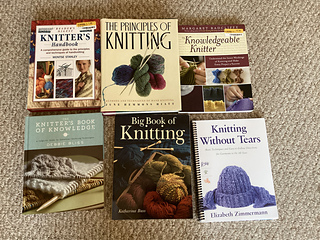
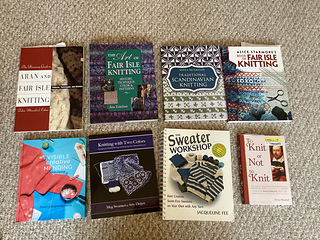
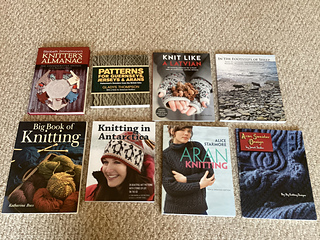
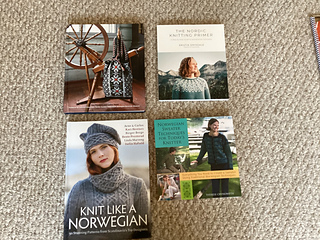
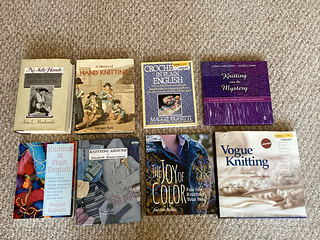
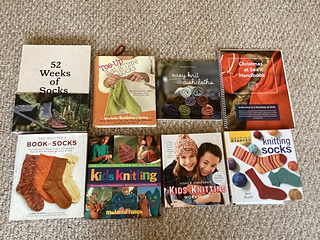
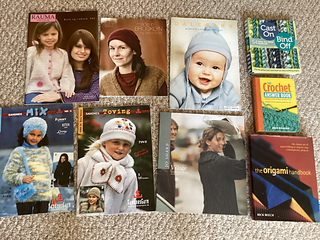




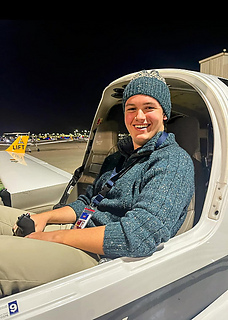
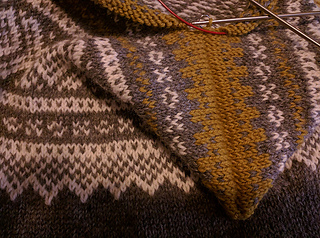
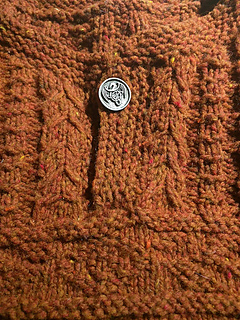
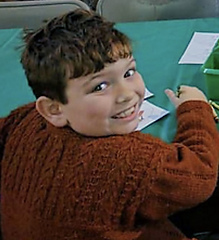
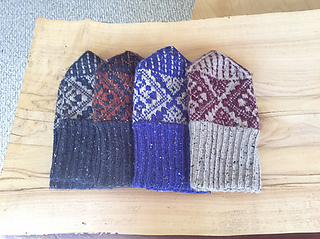

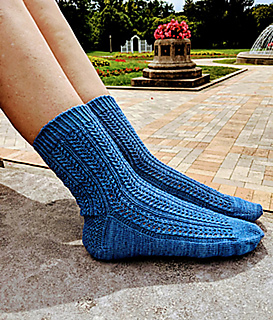

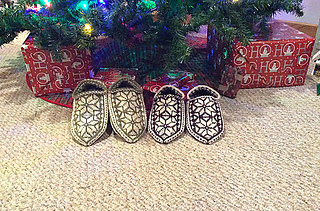
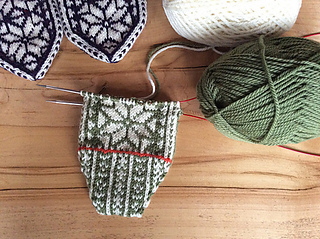
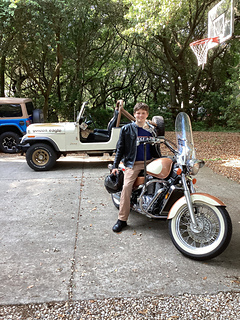

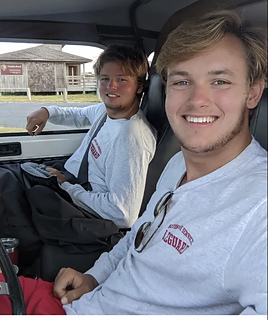
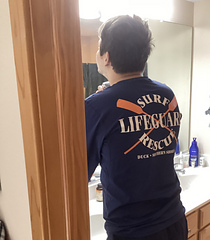
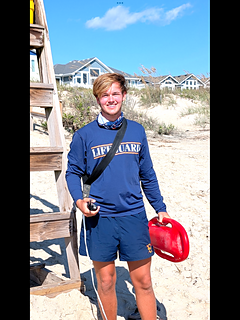

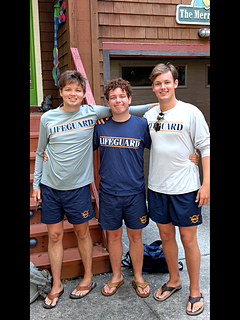
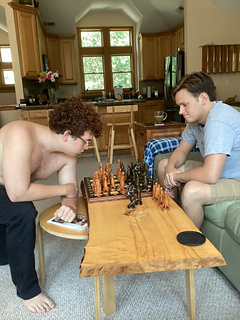

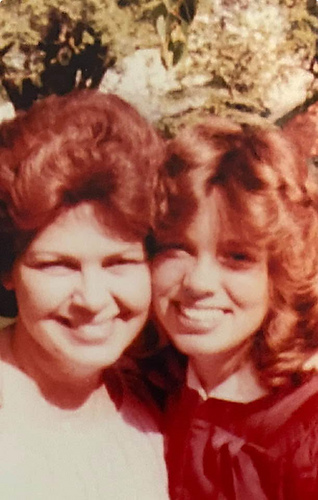





















 handspun
handspun queue
queue favorites
favorites friends
friends needles & hooks
needles & hooks library
library